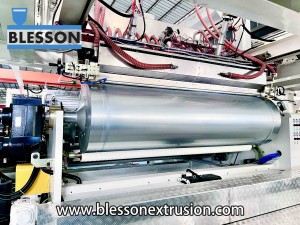In the current wave of the global pursuit of sustainable energy solutions, the significance of lithium batteries, as a key technology for efficient and clean energy storage, is self-evident. And the lithium battery separator, as a crucial component of lithium batteries, directly affects the performance, safety, and service life of the batteries. So, what exactly is the production process of lithium battery separators?
The separators in the lithium battery market are usually manufactured via a “wet” or “dry” process. In the “dry” process, polypropylene (PP) or polyethylene (PE) raw materials are first fed into an extruder. The extruder plays an extremely critical role in the entire lithium battery separator film production line. It can heat, melt, and blend the raw materials, transforming the originally solid polypropylene or polyethylene into a uniform molten state. Subsequently, through the shaping of a specific die of the extruder, the melt is extruded into a thin sheet shape. This thin sheet will undergo a rapid drawdown process in the subsequent procedures. This drawing process is one of the core steps in the dry process. It can make the molecular structure of the separator material arrange in an orderly manner along the drawing direction, thereby significantly improving the mechanical and physical properties of the separator, such as strength, toughness, etc., providing a reliable guarantee for the stable operation of lithium batteries.
Blesson Company has excellent technology and rich experience in the field of lithium battery separator production. During the implementation of the dry process, Blesson adopts advanced extruder equipment and precisely controls key parameters such as extrusion temperature, pressure, and melt flow rate to ensure that the thickness of the extruded thin sheet is uniform and the quality is stable. In the rapid drawdown stage, Blesson’s production line is equipped with high-precision drawing devices that can accurately set the draw ratio and drawing speed according to different product requirements, enabling the produced lithium battery separators to reach the industry-leading level in key indicators such as porosity and air permeability.
In terms of the “wet” process, it has different process characteristics from the dry process. The wet process usually first mixes an organic solution with a polymer to form a uniform solution system and then extrudes it through a specific die to form a gel-like film. This gel film needs to go through multiple processes such as extraction and drying in the subsequent treatment process to remove the solvent components and finally obtain a lithium battery separator with a microporous structure. In the entire wet production process, the control requirements for the concentration, viscosity of the solution, and the process conditions of each process are extremely high.
Whether it is the dry process or the wet process, quality control in the production process of lithium battery separators is a crucial link. From the inspection of raw materials, to the online monitoring during the production process, and then to the strict inspection of finished products, each step requires the use of high-precision testing equipment and a sound quality management system. Blesson Company has always attached great importance to product quality and is equipped with advanced testing instruments such as high-precision thickness gauges on its production line, which can monitor the various performance indicators of products in real-time and timely detect and adjust deviations in the production process.
With the rapid development of fields such as new energy vehicles and energy storage systems, the demand for lithium battery separators shows an explosive growth trend. Lithium battery separator production enterprises face challenges in multiple aspects such as increasing production capacity, improving product quality, and reducing costs. Blesson is continuously increasing its investment in research and development and production equipment upgrades, and is committed to exploring more efficient, environmentally friendly, and economical production processes. For example, by optimizing the design and performance of the extruder and increasing the degree of automation of the production line, etc., to enhance its competitiveness in the global market.
In conclusion, the production process of lithium battery separators is a complex and highly technical process. Whether it is the dry process or the wet process, enterprises need to have strong strength in multiple aspects such as equipment, technology, and management.
Post time: Dec-20-2024



